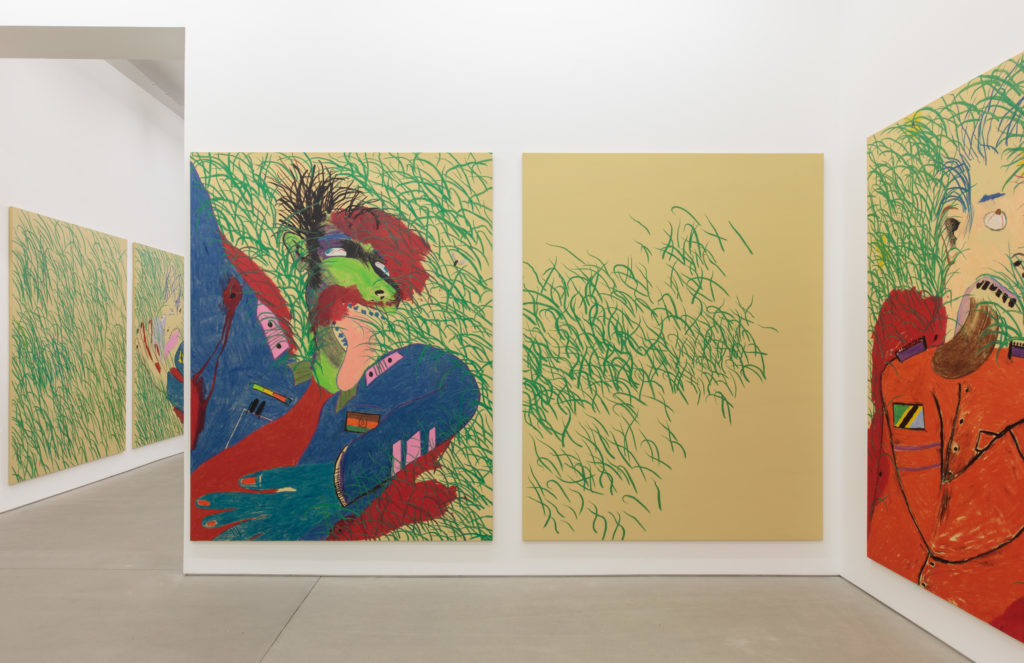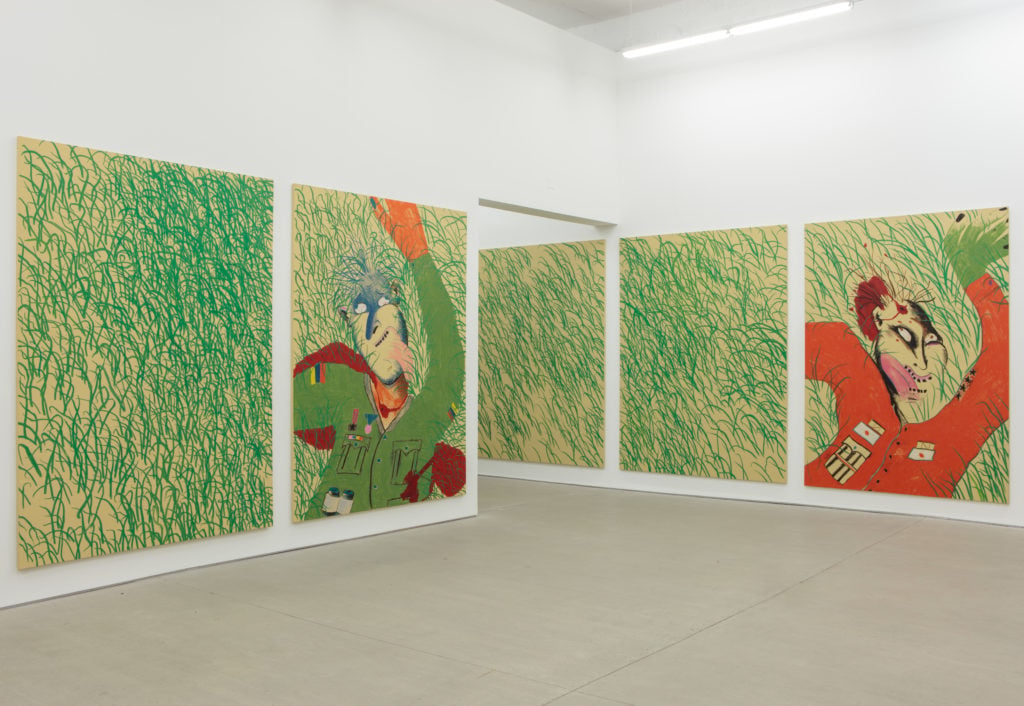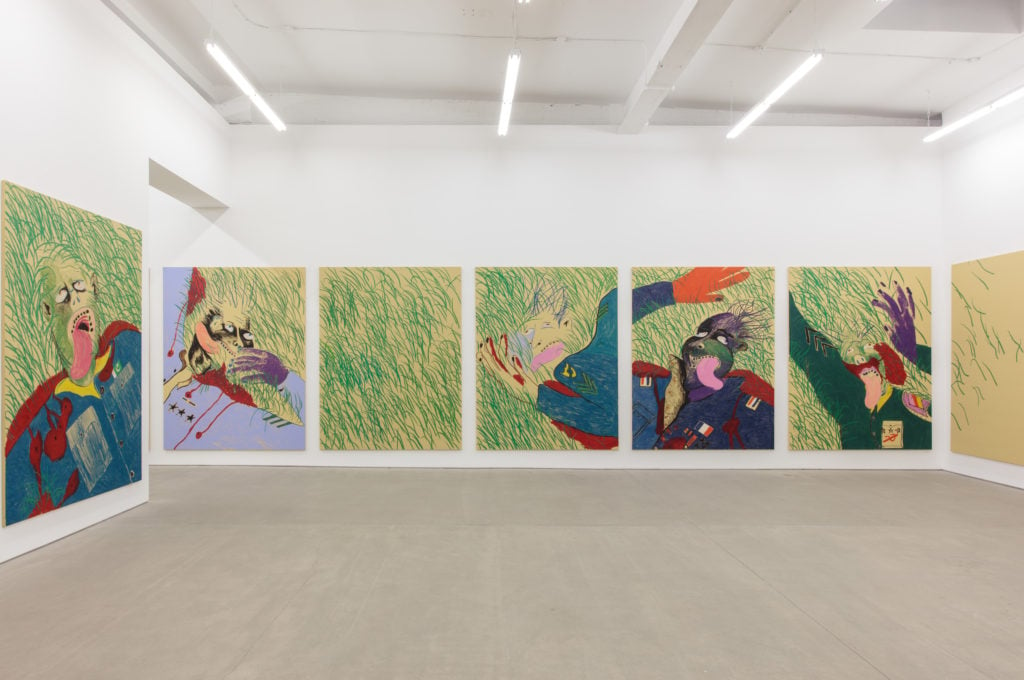On View
Calvin Marcus Turns Clearing Gallery Into a Battlefield of Crayon Military Men
In his latest show, Calvin Marcus turns the gallery into a battlefield.

In his latest show, Calvin Marcus turns the gallery into a battlefield.

Kat Herriman

The first time artist Calvin Marcus showed his work in a solo show in New York, in 2015, he transformed Clearing Gallery into an emotional fun house with nine monochromatic self-portraits in a high-fired ceramic set on tempered hardboard. For his second act, Were Good Men, currently on view, Marcus turns the gallery space into a battlefield. On the heels of his militarized drawings at 2015 Frieze New York, Marcus’s new show blows up his crayon and sharpie soldiers into a life-size army.
“The imagery, colors, marks, etc. of the drawings seemed to need to be enlarged to have the viewing experience become more visceral,” Marcus told artnet News. “Something that I made quickly as a small drawing was then faithfully reproduced at a larger scale, which really brought out the oddity of certain intuitive things I did on the original.”
Marcus’s painted military men are more imposing than their predecessors. They stare down from the wall in agony: blood shot eyes, blood-stained clothes, blood gushing out of unknowable holes. Languid tongues protrude from toothy grins. Unlike the works on paper which flanked the fair’s walls, Marcus’s men exist in a universe unto themselves—a landscape dominated by gore and grass. Each canvas soars nine feet high. Some depict mangled soldiers, others stripes of grass. Together, the canvases form a thicket, which engulfs the viewer whole.

For the project, Marcus created custom oil sticks, a scaled substitute for his crayons. “I have always had this problem with trying to make quick off-the-cuff drawings or energetic sketches into more substantial works,” Marcus said. “Things get fussy and stiff.” Created in partnership with paint maker Robert Doak, Marcus developed several Crayola inspired colors including Royal Purple, Wild Strawberry, Asparagus, and Dandelion.
Marcus applies the oil with the same ease one observes in his drawings. Each blade of grass is another thick smear of wax and pigment. The surface of his paintings bring to mind the familiar waxiness that one usually associates with coloring books and the backs of menus. The medium offers some comic relief to Marcus’s image of a living world visited only by death. Hung side by side, the cartoonish figures form a cyclorama where a viewer doesn’t know if she’s looking at the dying or the already deceased.
The installation mimics how Marcus works in the studio. His paintings are generally made in a series, or simultaneously. “I always set out to make an exhibition, which, out of necessity, seems to always insist on some feeling of seriality,” Marcus said. “When I’m pursuing a show, I am mostly imagining the actual opening and how each part will work for the exhibition and really let that drive how some of the works are even made. That’s not to say that I don’t finish each work to the level that I think it needs to be to be autonomous.” His repetition of imagery borders on obsession, but it’s this intensity that gives energy to his slapdash soldiers.

“The viewer is the spectator,” Marcus said when asked if he sees the viewer as the enemy. Even if one wanted to get involved, it would be hard to pick sides. The soldiers’ uniforms are purposely inconsistent—rendered in a palette of turquoise, red, purple, and lemon. “I randomly attached flags and colors to figures from as many different places as I could in an effort to make it feel as if the entire world was in the room,” said Marcus. “All served the same fate, the same way, together, in the same field, sinking back in the earth together. A leveling of man takes place, a reduction of humanity where, in the very beginning and in the very end everyone is the same. Which seems important to point out, which maybe is the most relevant moral question about identity.”
The show’s title, Were Good Men, perfectly encapsulates the inherent paradox it presents. “It’s difficult for everyone to be a good man at the same time,” said Marcus. Looking into the chaotic ranks, one finds that the similarities overwhelm the differences. In Infinite Jest, David Foster Wallace summarizes this phenomenon best: “Everybody is identical in their secret unspoken belief that way deep down they are different from everyone else.” Marcus leaves one to ponder real empathy in a room of fake war.
“Were Good Men” is on view through October 30 at C L E A R I N G in Bushwick, Brooklyn.